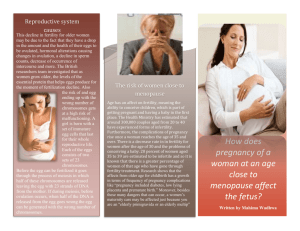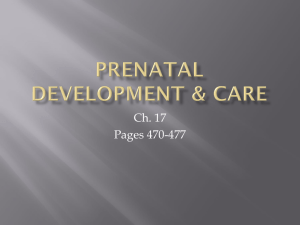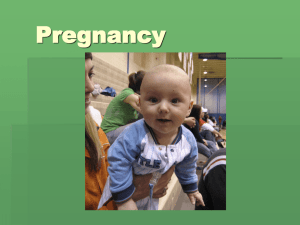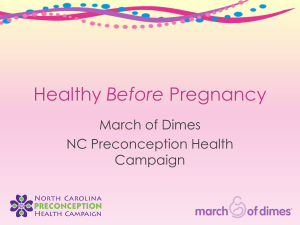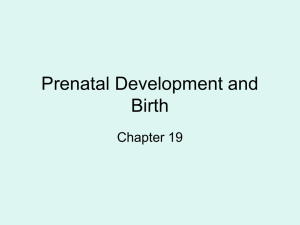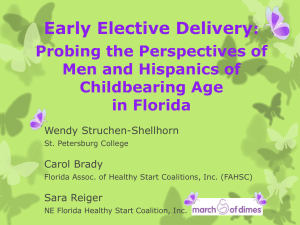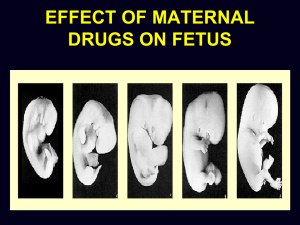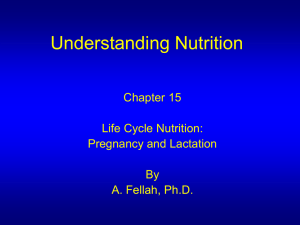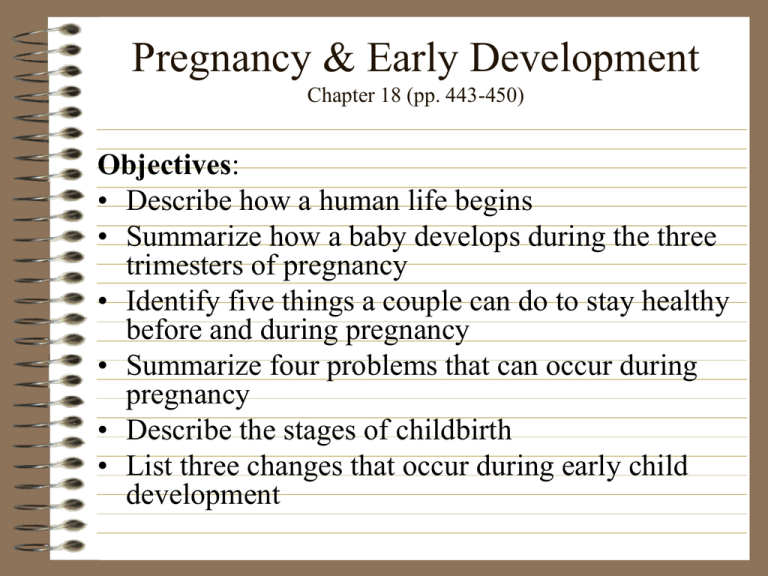
Pregnancy & Early Development
Chapter 18 (pp. 443-450)
Objectives:
• Describe how a human life begins
• Summarize how a baby develops during the three
trimesters of pregnancy
• Identify five things a couple can do to stay healthy
before and during pregnancy
• Summarize four problems that can occur during
pregnancy
• Describe the stages of childbirth
• List three changes that occur during early child
development
Do Now
• Why do you think genes are so important in
the development of a fetus?
• What factors should a couple consider
before they decide to have children?
Fertilization (conception)
• The joining of the sperm and
egg in the fallopian tube
Zygote
• A one-celled fertilized egg
–Image (2h after fertilization)
Blastocyst
• The dividing mass of cells of the
fertilized egg before implantation
Implantation
• The fertilized egg attaches itself to the
uterus
Embryo
• A developing human from fertilization
through the first
8 weeks of development
• In the seventh week, the embryo has both
male and female primordial ducts
– x chromosome = female structures
– y chromosome = male organs (hormonal switch happens)
Placenta
• An organ that will
form during
pregnancy to
nourish the
developing embryo
and fetus
• It comes out after
birth
• Mother’s Circulation
– Oxygen
– Drugs, Alcohol
– Nutrients
– Immunities
– Viruses
– Hormones
• Fetus’ Circulation
– Wastes
– Carbon Dioxide
– Hormones
Umbilical Cord
• Anything in the mother’s
blood can enter the baby’s
blood through the
umbilical cord, by way of
the placenta
• A cord that connects
the developing baby to
the placenta
Amniotic Sac
• A sac filled
with fluid
(Amniotic
Fluid) which
protects the
baby during
pregnancy
Trimesters of Pregnancy
Stages of Development
• Click on the following links to learn about
fetal development:
• http://www.epigee.org/fetal.html
•
http://www.nlm.nih.gov/medlineplus/ency/a
rticle/002398.htm
First Trimester (months 1-3)
• Fourth week:
–
–
–
–
heart starts beating
Arm and leg buds appear
Eyes and brain begin to develop
Size of a BB pellet
Second Trimester (months 4-6)
• The mother can feel the fetus move or
“kick”
• Reproductive organs can be recognized as
male or female
• Fetus can hear and recognize voices
• Hair forms on the body
• Head and facial features become apparent
• Fingers and toes grow nails
Third Trimester (months 7-9)
•
•
•
•
•
Fetus gains most of its weight
Brain develops further
All other organs are almost complete
Fetus can grasp with his or her hands
Fetus’ nervous system will continue to
develop after birth
Keeping Healthy Before and During
Pregnancy
• Avoid alcohol and other drugs, and
exposure to cigarette smoke
• Maintain a nutritious diet and eat regular
meals
• Take prenatal vitamins
• Get regular, moderate levels of exercise
• Have regular checkups with a healthcare
provider
Problems During Pregnancy
• Fetal alcohol syndrome (FAS)
– http://www.kidshealth.org/parent/medical/brain/fas.html
• Miscarriage (death before 20th week)
• Ectopic pregnancy
– http://www.kidshealth.org/parent/pregnancy_newborn/pregnancy/ectopic.
html
• Toxemia
– http://familydoctor.org/online/famdocen/home/women/pregnancy/complic
ations/064.html
• Gestational diabetes
– http://www.kidshealth.org/parent/question/infants/gestational_diabetes.ht
ml
• Rh incompatibility
– http://www.kidshealth.org/parent/pregnancy_newborn/pregnancy/rh.html
• Premature birth (delivery before 38th week)
Ectopic Pregnancy
• When a fertilized
egg implants
anywhere but in the
uterus, usually in
the fallopian tube
• This is dangerous
and must be
removed
Miscarriage
• Also known as a
Spontaneous Abortion
• When a pregnancy will end
by itself, usually during the
first three months
Abortion
• When a pregnancy is
terminated on purpose
Childbirth
1. Labor (dilation)
2. Expulsion
3. Afterbirth (placental)
Labor
• Begins with contractions and
ends when the cervix is
completely dilated
• The longest stage of
childbirth
Cervix dilating
0-10 cm
Cervix fully dilated
@ 10 cm
Head appears after full dilation of
cervix
Expulsion
• Passage of the baby through
the birth canal
• The baby is “expelled”
• Ends when the umbilical
cord is cut
Afterbirth Passage
• A few minutes after the
umbilical cord is cut, the
mother delivers the placenta
and the rest of the umbilical
cord
Episiotomy
• An incision
made in the skin
below the vagina
to facilitate the
passage of the
baby through the
vagina
Breech Birth
• When a baby comes out
anyway other than head first,
usually feet first
Caesarian Section
• The surgical removal of the
baby through the abdomen
Video: What to expect with a caesarian delivery
http://mayoclinic.com/health/c-section/MM00531
Multiple Births
• Identical Twins
• Fraternal Twins
• Triplets
• ETC.
Identical Twins
• Fertilized egg splits
• They will share one placenta
• They will always be the same
sex and are “identical”
Fraternal Twins
• Two separate eggs are fertilized
by two separate sperm
• They will have their own
placenta
• They are not “Identical”
Epidural Anesthesia
• Anesthesia given to a woman in her back
for pain relief of labor and delivery.
• Woman does not feel pain, but she and the
baby are not drugged.
Closure
• Describe the importance of prenatal care for
keeping healthy before and during
pregnancy.
Works Cited
• Textbook: Lifetime Health (2004)
• Fetal Development Overview at http://www.wcpc.org/fetal.html
• Mayo Foundation for Education research
athttp://www.mayohealth.org/mayo/baby/htm/ww5r450.ht
ml
• www. Google images
• http://mayoclinic.com/health/prenatal-care/PR00112



